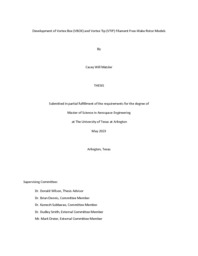
ATTENTION: The works hosted here are being migrated to a new repository that will consolidate resources, improve discoverability, and better show UTA's research impact on the global community. We will update authors as the migration progresses. Please see MavMatrix for more information.
Show simple item record
| dc.contributor.advisor | Wilson, Donald | |
| dc.creator | Matsler, Casey Will | |
| dc.date.accessioned | 2023-06-14T17:04:50Z | |
| dc.date.available | 2023-06-14T17:04:50Z | |
| dc.date.created | 2023-05 | |
| dc.date.issued | 2023-03-13 | |
| dc.date.submitted | May 2023 | |
| dc.identifier.uri | http://hdl.handle.net/10106/31208 | |
| dc.description.abstract | Rotor models span from simple static and first order expressions to high fidelity, numerical computations and across the spectrum each model is good for different purposes. The use of models has improved with time and technological capability but choosing the right model for the task is important. A survey of rotor models is performed to identify a rotor model flexible enough for providing high to moderately high-fidelity results without significantly sacrificing computational time. The model chosen is intended to be for general purposes and applicable across a wide range of operating conditions. From the survey, a blade element rotor model is chosen and combined with two vortex-theory free-wake models. The blade element rotor model allows for large range of flexibility to model many physical aspects of rotors. The vortex-theory free-wake model was selected for the ability to simulate a rotor wake’s physical characteristics and still provide solid inflow modeling for coupling with the blade motion dynamics. The purpose of having two versions of vortex-theory free-wake models is to quantify the differences of choosing whether or not to satisfy Helmholtz’s Law for termination of a vortex filament.
The satisfaction of Helmholtz’s Law is accomplished by emitting four vortex filaments with constant vorticity strength each time step that are adjoined to make a closed box representing the shed, bound and tip vortices. The second vortex-theory free-wake model only emits one filament from the tip of each blade per time step creating a streamer of filaments each with varying vorticity strength.
The development of the rotor blade element model and the vortex-theory free-wake models are described along with the momentum theory inflow model used for comparison and validation. The resulting models are compared against empirical performance calculations, experimental test data, and physical wake characteristics from theory and reality.
Results from the blade element model with both vortex-theory free-wake models show good correlation with rotor power and induced velocity predictions. The vortex-theory free-wake models capture lateral flapping trends that uniform, momentum theory inflow models fail to predict. The velocity field resulting from the vortex-theory free-wake models strongly align with known wake characteristics such as wake contraction and vortex tip roll up during forward flight. The interactions of the vortices also suggest that the free-wake models are capturing transient vibration effects during transitional speeds. The wake dynamics show similar results to accepted dynamic inflow models and show the apparent mass effects described in the development of the dynamic inflow models. Resulting similarity in the two vortex-theory free-wake models indicate that satisfaction of Helmholtz’s Law is not strictly necessary for creating good rotor analysis tools. | |
| dc.format.mimetype | application/pdf | |
| dc.language.iso | en_US | |
| dc.subject | Rotor model | |
| dc.subject | Vortex theory | |
| dc.subject | Free wake | |
| dc.subject | Rotor performance | |
| dc.title | Development of Vortex Box (VBOX) and Vortex Tip (VTIP) Filament Free-Wake Rotor Models | |
| dc.type | Thesis | |
| dc.date.updated | 2023-06-14T17:04:50Z | |
| thesis.degree.department | Mechanical and Aerospace Engineering | |
| thesis.degree.grantor | The University of Texas at Arlington | |
| thesis.degree.level | Masters | |
| thesis.degree.name | Master of Science in Aerospace Engineering | |
| dc.type.material | text | |
Files in this item
- Name:
- MATSLER-THESIS-2023.pdf
- Size:
- 1.604Mb
- Format:
- PDF
This item appears in the following Collection(s)
Show simple item record


